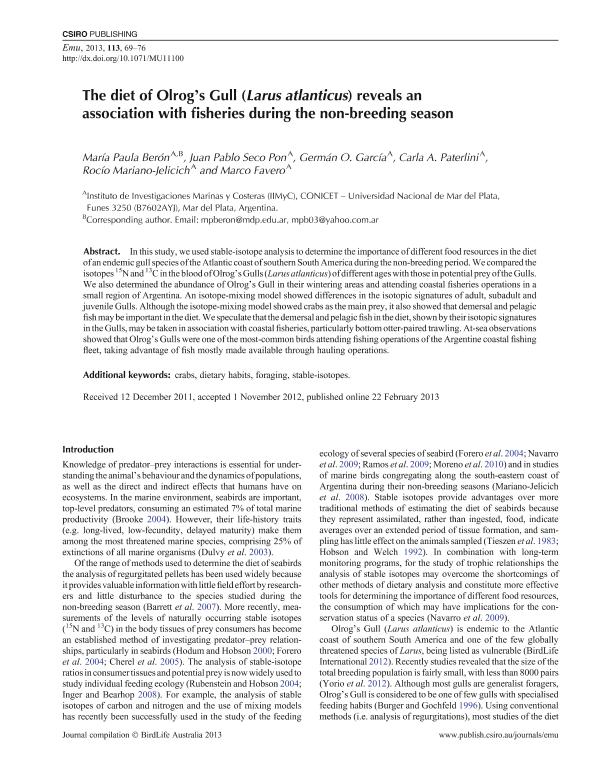Artículo
The diet of Olrog’s Gull (Larus atlanticus) reveals an association with fisheries during the non-breeding season
Beron, Maria Paula ; Seco Pon, Juan Pablo
; Seco Pon, Juan Pablo ; García, Germán Oscar
; García, Germán Oscar ; Paterlini, Carla Ángela; Mariano y Jelicich, Rocío
; Paterlini, Carla Ángela; Mariano y Jelicich, Rocío ; Favero, Marco
; Favero, Marco
 ; Seco Pon, Juan Pablo
; Seco Pon, Juan Pablo ; García, Germán Oscar
; García, Germán Oscar ; Paterlini, Carla Ángela; Mariano y Jelicich, Rocío
; Paterlini, Carla Ángela; Mariano y Jelicich, Rocío ; Favero, Marco
; Favero, Marco
Fecha de publicación:
02/2013
Editorial:
Csiro Publishing
Revista:
Emu
ISSN:
0158-4197
Idioma:
Inglés
Tipo de recurso:
Artículo publicado
Clasificación temática:
Resumen
In this study, we used stable-isotope analysis to determine the importance of different food resources in the diet of an endemic gull species of the Atlantic coast of southern South America during the non-breeding period.We compared the isotopes 15N and 13C inthe blood of Olrog’s Gulls (Larus atlanticus) of different ages withthose in potential prey of the Gulls. We also determined the abundance of Olrog’s Gull in their wintering areas and attending coastal fisheries operations in a small region of Argentina. An isotope-mixing model showed differences in the isotopic signatures of adult, subadult and juvenile Gulls. Although the isotope-mixing model showed crabs as the main prey, it also showed that demersal and pelagic fish may be important inthe diet.We speculate thatthe demersal and pelagic fishinthe diet, shown by their isotopic signatures in the Gulls, may be taken in association with coastal fisheries, particularly bottom otter-paired trawling. At-sea observations showed that Olrog’s Gulls were one of the most-common birds attending fishing operations of the Argentine coastal fishing fleet, taking advantage of fish mostly made available through hauling operations
Palabras clave:
Crabs
,
Dietary Habits
,
Foraging
,
Stable-Isotopes
Archivos asociados
Licencia
Identificadores
Colecciones
Articulos(CCT - MAR DEL PLATA)
Articulos de CTRO.CIENTIFICO TECNOL.CONICET - MAR DEL PLATA
Articulos de CTRO.CIENTIFICO TECNOL.CONICET - MAR DEL PLATA
Citación
Beron, Maria Paula; Seco Pon, Juan Pablo; García, Germán Oscar; Paterlini, Carla Ángela; Mariano y Jelicich, Rocío; et al.; The diet of Olrog’s Gull (Larus atlanticus) reveals an association with fisheries during the non-breeding season; Csiro Publishing; Emu; 113; 2-2013; 69-76
Compartir
Altmétricas



